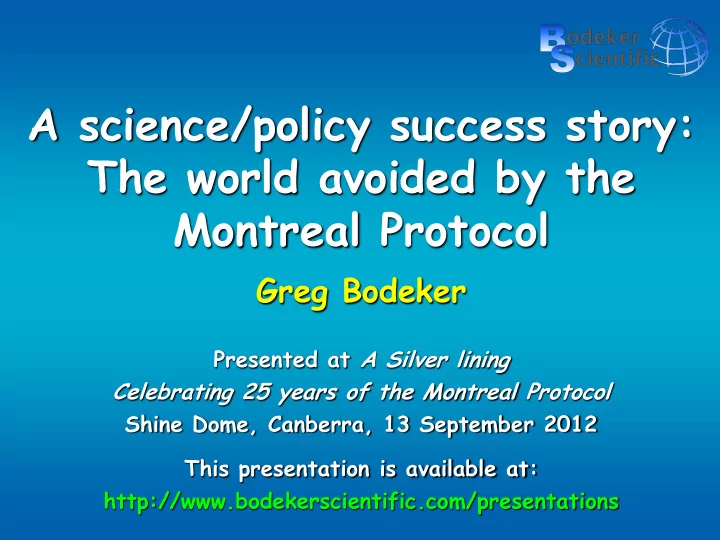

A science/policy success story: The world avoided by the Montreal Protocol Greg Bodeker Presented at A Silver lining Celebrating 25 years of the Montreal Protocol Shine Dome, Canberra, 13 September 2012 This presentation is available at: http://www.bodekerscientific.com/presentations
Overview Chemistry climate model simulations of changes in the ozone distribution under a scenario where emissions of ozone depleting substances grow by 3%/year from 1974 to 2075. Newman et al. (2009), What would have happened to the ozone layer if chlorofluorocarbons (CFCs) had not been regulated?, Atmos. Chem. Phys. , 9, 2113 – 2128. Available from: http://www.atmos-chem-phys.net/9/2113/2009/acp-9-2113-2009.pdf How stratospheric halogen loading would have changed under such a scenario. Changes in ozone globally. Ozone and UV radiation over Canberra for such a scenario compared to what we expect will happen following the success of the Montreal Protocol. The importance of the Montreal Protocol in protecting climate.
A chemistry climate model simulation The world is complicated… Ozone absorbs incoming and outgoing radiation ozone destruction alters temperature and wind distributions in the atmosphere affects transport of ozone and other gases. Temperature changes affect ozone loss rates, producing a feedback that further alters the ozone distribution. Proper simulation of the world avoided requires a chemistry- climate model with interactive radiation, chemistry, and dynamics. Projections of the future evolution of the stratosphere are shown using simulations conducted using GEOSCCM.
Stratospheric halogen loading Natural level of EESC is ~1.2 ppb. In the Ab scenario, EESC peaks at ~4.3 ppb in 2002. Under the ‘World Avoided’ scenario, EESC increases to 11.5 ppb by 2020, 29.6 ppb by 2050 and 45.6 ppb by 2065. Under the Ab EESC = equivalent effective scenario EESC falls stratospheric chlorine to 3.8 ppb by 2020 A measure of the halogen loading and to 2.8 ppb by effective in destroying ozone. 2050.
A quick global view of what ozone would have done at 20 km altitude Collapse of tropical ozone from 2052 to 2058. Tropical cooling leads to on-set of ozone hole chemistry around 2052
Life in Canberra with Montreal Protocol
Life in Canberra without Montreal Protocol
Life in Canberra without Montreal Protocol 404-430 377-404 351-377 325-351 Oct 2000 299-325 272-299 246-272 220-246 194-220 167-194 141-167 115-141 89-115 62-89 36-62 10-36 Oct 2030 Oct 2070 Oct 2070
What does this mean for UV index? Summer-time (1 January) clear-sky surface UV index for Canberra 1980: UV index>10 10:30 to 14:00 2030: UV index>10 09:40 to 15:00 2070: UV index>10 08:30 to 15:50
What about Antarctica? What begins as an Antarctic ozone hole in October, spreads through the course of the century to become a year round phenomenon.
But would it ever have come to this? Most likely not. Many ozone depleting substances (ODSs) are also greenhouse gases (GHGs) and often are very potent GHGs CFC11 – GWP=4680 CFC12 – GWP=10702 CFC114 – GWP=9880 CFC115 – GWP=7250 Effects of ODS emissions on climate would have become apparent well before mid-21 st century. The ODSs would have added an additional 0.8 to 1.6 Wm -2 of radiative forcing by 2010 if the ODS emissions had continued to grow at 3-7%/year after 1974.
The importance of the Montreal Protocol in protecting climate Velders et al., Proceedings of the National Academy of Sciences , 104(12), 4814-4819. In 2010, the decrease of annual ODS emissions under the Montreal Protocol is ~10 Gt of avoided CO 2 -equivalent emissions per year 5 times larger than the annual emissions reduction target for Kyoto Protocol 1 st commitment period.
Conclusions 17% of the globally-averaged ozone is destroyed by 2020. 67% by 2065 in relation to 1980 values. Largest losses are in polar regions. Large polar ozone depletion becomes year round. Changes in vertical motion in the tropical lower stratosphere causes cooling initiates ozone hole chemistry collapse of tropical ozone around mid-century. Over Canberra: Ozone declines steadily, reaching ozone hole type levels (220 DU) by ~2040 and ozone values as low as ~100 DU by 2075. UV daily period of UV index>10 expands from 3.5h to 7.5h and peak UV indices exceed 35. Extreme UV levels would also affect tropospheric chemistry, tropospheric ozone radiative forcing, and biogeochemical processes. Montreal Protocol has played a key role in protecting climate.
Recommend
More recommend